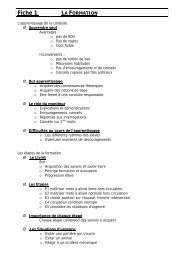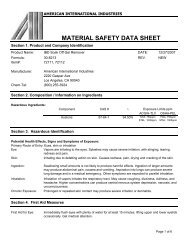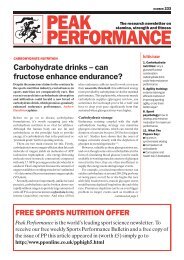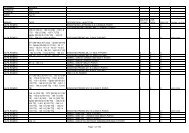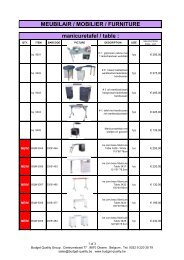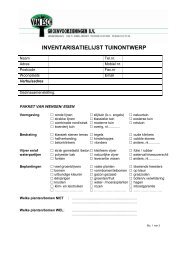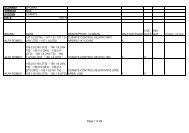material safety data sheet - Proximedia
material safety data sheet - Proximedia
material safety data sheet - Proximedia
You also want an ePaper? Increase the reach of your titles
YUMPU automatically turns print PDFs into web optimized ePapers that Google loves.
AMERICAN INTERNATIONAL INDUSTRIES<br />
Section 1. Product and Company Identification<br />
Product Name: EzFlow Tip Blender DATE: 12/27/2007<br />
Formula: 30-1303<br />
REV. NEW<br />
Item#:<br />
87-5168, 66034<br />
Manufacturer: American International Industries<br />
2220 Gaspar Ave<br />
Los Angeles, CA 90040<br />
Chem-Tel: (800) 255-3924<br />
Section 2. Composition / Information on Ingredients<br />
Hazardous Ingredients:<br />
Section 3. Hazardous Identification<br />
CAS # %<br />
96-48-0 70-80<br />
64-17-5 20-30<br />
Emergency Overview: WARNING!<br />
BIRTH DEFECT HAZARD. CONTAINS MATERIAL WHICH CAN CAUSE BIRTH DEFECT.<br />
CONTAINS MATERIAL WHICH CAUSES DAMAGE TO THE FOLLOWING ORGANS: BLOOD,<br />
NERVOUS SYSTEM, REPRODUCTIVE SYSTEM, LIVER, RESPIRATORY TRACT, EYES,<br />
CENTRAL NERVOUS SYSTEM.<br />
FLAMMABLE LIQUID AND VAPOR. VAPOR MAY CAUSE FLASH FIRE. MAY CAUSE EYE<br />
AND SKIN IRRITATION.<br />
Keep away from heat, sparks and flame. Avoid contact with eyes, skin and clothing. Keep<br />
container closed. Use only with adequate ventilation. Avoid exposure during pregnancy. Wash<br />
thoroughly after handling.<br />
Potential Health Effects, Signs and Symptoms of Exposure:<br />
Primary Route of Entry: Eyes, skin, inhalation and ingestion.<br />
Eye:<br />
Irritation and tearing may result if exposed to above exposure limits.<br />
Skin:<br />
Ingestion:<br />
MATERIAL SAFETY DATA SHEET<br />
Component<br />
Gamma-Butyrolactone<br />
Ethanol<br />
Exposure Limits<br />
Not available<br />
TWA: 1000ppm from OSHA (PEL)<br />
TWA: 1000ppm from ACGIH (TLV)<br />
May cause drying, redness and irritation. May be absorbed through damaged skin.<br />
One ounce of pure ethanol may cause reddening of face and neck, and an exaggerated feeling of<br />
well-being. Three ounces of pure ethanol may cause an initial burst of excitement and activity<br />
followed by increasing loss of coordination, slurred speech, nausea and drowsiness. This may<br />
proceed to stupor, coma, and death. Lethal dose of ethanol ranges from two to five ounces,<br />
depending on age and size of the individual.<br />
Page 1 of 6
Inhalation:<br />
Potential Chronic<br />
Health Effects:<br />
Medical Conditions<br />
Aggravated by<br />
Overexposure:<br />
Overexposure/<br />
Signs/Symptoms:<br />
First Aid for Eye:<br />
First Aid for Skin:<br />
First Aid for Inhalation:<br />
First Aid for Ingestion:<br />
Notes to physicians:<br />
Section 5. Fire Fighting Measures<br />
AMERICAN INTERNATIONAL INDUSTRIES<br />
MATERIAL SAFETY DATA SHEET<br />
Flash Point (°F/°C): The lowest known value is CLOSED CUP: 12°C (53.6°F). (Ethanol)<br />
Flammable Limit<br />
(vol%):<br />
Auto-ignition Temp.<br />
(vol%)<br />
Products of<br />
Combustion:<br />
Levels of 5000ppm to 10000ppm may result in irritation of mouth, nose, and throat, coughing, and<br />
leading to sleep and stupor.<br />
CARCINOGENIC EFFECTS: Classified A4 (Not classifiable for human or animal.) by ACGIH<br />
Long term exposure: Prolonged inhalation may produce symptoms listed under inhalation and<br />
additional symptoms of headache, dizziness, tremor and fatigue. Alcohol has been linked to birth<br />
defects in humans.<br />
Repeated or prolonged exposure to this product may aggravate existing skin, eye, and/or<br />
respiratory condition.<br />
Not available.<br />
Section 4. First Aid Measures<br />
Check for and remove and contact lenses. Immediately flush with water for at least 15 minutes,<br />
including under eyelids. Cold water may be used. Get medical attention.<br />
In case of contact, immediately flush skin with plenty of water. Cover the irritated skin with an<br />
emollient. Remove contaminated clothing and shoes. Cold water may be used. Wash clothing<br />
before reuse. Thoroughly clean shoes before reuse. Get medical attention.<br />
If symptoms of prolonged exposure to concentrated <strong>material</strong>s vapors appear, remove to fresh air.<br />
If breathing is difficult, loosen any restrictive clothing and provide oxygen and get medical care if<br />
necessary.<br />
Do NOT induce vomiting unless otherwise directed to do so by medical personnel. Never give<br />
anything by mouth to an unconscious person. Loosen tight clothing such as collar, tie, belt or<br />
waistband. Get medical attention if symptoms appear.<br />
Medical surveillance: For those with frequent or potential high exposure, liver function tests are<br />
recommended. Ethanol can be measured in the blood, urine, and exhaled breath.<br />
The greatest known range is LOWER: 3.3% UPPER: 19% (Ethanol)<br />
The lowest known value is 455°C (851°F)<br />
These products are carbon oxides (CO, CO2)<br />
Page 2 of 6
Fire Hazards in<br />
Presence of Various<br />
Substances:<br />
Explosion Hazards in<br />
Presence of Various<br />
Substances<br />
Fire Fighting Media:<br />
Protective Clothing<br />
(Fire):<br />
Special Remarks on<br />
Fire Hazards:<br />
Special Remarks on<br />
Explosion Hazards:<br />
Small Spill and Leak:<br />
Large Spill and Leak:<br />
Handling:<br />
Storing:<br />
AMERICAN INTERNATIONAL INDUSTRIES<br />
Not available.<br />
None known.<br />
Carbon Dioxide (CO2)<br />
Not available.<br />
Not available.<br />
MATERIAL SAFETY DATA SHEET<br />
Be sure to use an approved/certified respirator or equivalent.<br />
Section 6. Accidental Release Measures<br />
Section 7. Handling and Storage<br />
Absorb with inert dry <strong>material</strong> and place in an appropriate waste disposal container.<br />
Flammable Liquid<br />
Keep away from heat. Keep away from source of ignition. Stop leak if without risk. Absorb with DRY<br />
earth, sand or other non-combustible <strong>material</strong>. Do not touch spilled <strong>material</strong>. Prevent entry into sewers,<br />
basements or confined areas; dike if needed. Eliminate all ignition sources.<br />
Keep away from heat, sparks or flames. Keep container closed. Only use with adequate<br />
ventilation. To avoid fire or explosion, dissipate static electricity during transfer by grounding and<br />
bonding containers and equipment before transferring <strong>material</strong>. Use explosion-proof electrical<br />
(ventilating, lighting and <strong>material</strong> handling) equipment.<br />
Product containing ethanol must be stored to avoid contact with strong oxidizers such as<br />
perchlorates, peroxides, chlorates, nitrates, and permenganates, because violent reactions occur.<br />
Store in tightly closed containers in cool, well-ventilated area away from heat or flame. Sources<br />
of ignition such as smoking and open flames are prohibited. Metal container involving transfer of<br />
5 gallons or more should be grounded and bonded. Drums must be equipped with self-closing<br />
valves and pressure vacuum bung. Use only non-sparking tools and equipment, especially when<br />
opening and closing container.<br />
Section 8. Exposure Controls / Personal Protective Equipment<br />
Page 3 of 6
Engineering Controls:<br />
Personal Protection:<br />
Personal Protection in<br />
Case of a Large Spill:<br />
AMERICAN INTERNATIONAL INDUSTRIES<br />
MATERIAL SAFETY DATA SHEET<br />
Appearance @ 25°C: Liquid. (Light Yellow) Viscosity (RVT): Not applicable<br />
Odor @ 25°C: Ester Vapor Pressure: The highest known value is 0.2kPa @ 20°C<br />
pH (1% soln/water) Acidic. Vapor Density: The highest known value is 1.6 (Air=1) (Ethanol)<br />
Specific Gravity: 0.9 (Water=1) Evaporation Rate: 9.2 (Ethanol) compared to Butyl Acetate<br />
Ignition: Not applicable VOC: 34%<br />
Boiling Point: The lowest known value is 78.4 (173.1°F) (Ethanol). Weighted average: 173.35°C (344°F)<br />
Melting/Freezing: May start to solidify at -43.5°C (-46.3°F)<br />
Solubility in Water<br />
Stability:<br />
Soluble in cold water,<br />
hot water.<br />
Section 10. Stability and Reactivity<br />
Hazardous Decomposition Products:<br />
Not available<br />
Incompatibility (Materials to Avoid):<br />
Hazardous Polymerization:<br />
Will not Occur<br />
Provide exhaust ventilation or other engineering controls to keep the airborne concentrations of<br />
vapors below their respective threshold limit value. Ensure that eyewash stations and <strong>safety</strong><br />
showers are proximal to the work-station location.<br />
Eyes: Splash goggles.<br />
Body: Synthetic apron.<br />
Respiratory: Vapor respirator. Be sure to use an approved/certified respirator or equivalent.<br />
Wear appropriate respirator when ventilation is inadequate.<br />
Hands: Gloves (Impervious)<br />
Feet: Not applicable.<br />
Splash goggles. Full suit. Boots. Gloves.<br />
Section 9. Physical and Chemical Properties<br />
The product is stable<br />
Reactive with oxidizing agents, acids, alkalis.<br />
Section 11. Toxicological Information<br />
Page 4 of 6
Chronic Effects on<br />
Humans:<br />
Other Toxic Effects on<br />
Humans:<br />
Section 12. Ecological Information<br />
No <strong>data</strong> available.<br />
AMERICAN INTERNATIONAL INDUSTRIES<br />
MATERIAL SAFETY DATA SHEET<br />
Waste must be disposed o in accordance with federal, state and local environmental control regulations.<br />
Section 14. Transportation Information<br />
<br />
Proper Shipping Name: Flammable Liquid , n.o.s. (Ethanol)<br />
Hazard Class: 3<br />
UN/NA: UN1993<br />
Packing Group: II<br />
Section 15. Regulatory Information<br />
HCS Classification Class:<br />
Class:<br />
Class:<br />
U.S Federal<br />
Regulations:<br />
Carcinogenic effects: Classified A4 (Not classifiable for human or animal.) by ACGIH.<br />
Developmental Toxicity: Classified Reproductive system/toxin/female, Reproductive<br />
system/toxin/male<br />
Prolonged inhalation may produce symptoms listed under inhalation and additional symptoms of<br />
headache, dizziness, tremor and fatigue. Alcohol has been linked to birht defects in humans.<br />
Section 13. Disposable Considerations<br />
Flammable Liquid having a flash point lower than 37.8°C (100°F)<br />
Target organ effects.<br />
Reproductive toxins.<br />
TSCA 8(b) inventory: Ethanol<br />
SARA 302/304/311/312 extremely hazardous substances: No products were found.<br />
SARA 302/304 emergency planning and notification: No products were found.<br />
SARA 302/304/311/312 hazardous chemicals: No products were found.<br />
SARA 311/312 MSDS distribution - chemical inventory - hazard identification: No products<br />
SARA 313 toxic chemical notification and release reporting: No products were found.<br />
Clean water Act (CWA) 307: No products were found<br />
Clean water Act (CWA) 311: No products were found<br />
Clean air act (CAA) 112 accidental release prevention: No products were found.<br />
Clean air act (CAA) 112 regulated flammable substances: Ethanol<br />
Clean air act (CAA) 112 regulated toxic substances: No products were found.<br />
Page 5 of 6
International<br />
Regulations:<br />
AMERICAN INTERNATIONAL INDUSTRIES<br />
State Regulations: Pennsylvania RTK: Ethanol<br />
Florida: Ethanol<br />
Minnesota: Ethanol<br />
Massachusetts RTK: Ethanol<br />
New Jersey: Ethanol<br />
Section 16. Other Information<br />
Hazard Material Information System (U.S.A.)<br />
Fire=3<br />
Health=1<br />
Reactivity=0<br />
National Fire Protection Association (U.S.A.)<br />
Fire=3<br />
Health=1<br />
Reactivity=0<br />
MATERIAL SAFETY DATA SHEET<br />
EINECS: Not available<br />
DSCL (EEC) R11-Highly flammable. R36/38-Irritating to eyes and skin.<br />
Page 6 of 6




